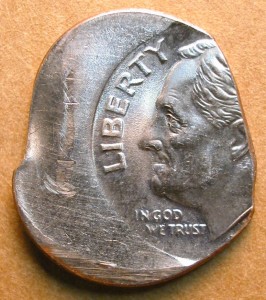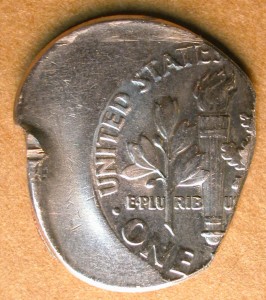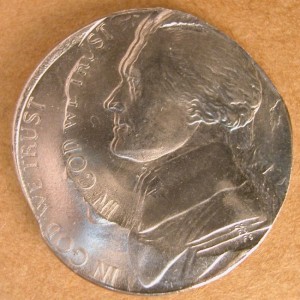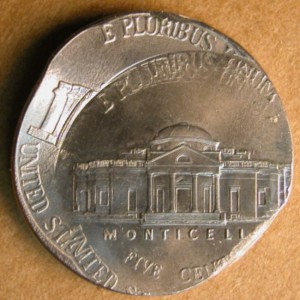Part IV. Striking Errors:
Foreign Object Chain Strike
Definition: A conventional chain strike occurs when the expanding edges of two adjacent discs of coin metal (2 planchets, 2 coins, or one of each) meet and flow together. A foreign object chain strike occurs when the edge of a coin metal disc and the edge of a foreign object meet and flow together. Right now, the only recognized foreign object chain strikes involve one member of a pair of feeder/ejection fingers that extend from the same feeder arm. These errors can therefore also be classified as a form of machine part impingement. Foreign object chain strikes involving other intrusive elements would be hard to recognize, unless they left a tell-tale residue on the edge of the coin or if they left the chain-struck edge with a very peculiar shape and/or texture.
The vast majority of foreign object chain strikes co-occur with a form of intra-strike damage at the opposite pole produced when the protruding portion of the off-center coin is pushed into the other feeder/ejection finger.
Most foreign object chain strikes are seen in multi-struck coins. These are invariably struck by inverted dies installed in the high-speed Schuler press.
This off-center dime shows a foreign object chain strike on the right side. Here the edge of the dime and the internal edge of a feeder/ejection finger met and flowed together. The edge of the dime is slightly convex and bears a 13 millimeter long contact facet. The opposite pole was pushed in when the protruding portion of the off-center coin was pushed into the other feeder/ejection finger. This form of intra-strike damage almost always accompanies a foreign object chain strike. The two together form a pattern of bilateral machine part impingement.
This quadruple-struck nickel shows a foreign object chain strike on the right side. Here the expanding edge of the nickel met the expanding edge of a feeder/ejection finger, leaving the former with a relatively straight edge. At the opposite pole we again see impact damage from the other feeder/ejection finger.



